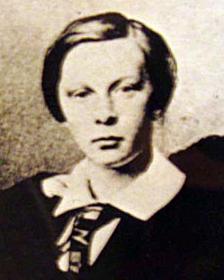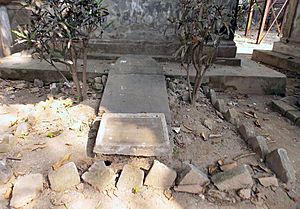Walter Landor Dickens facts for kids
Quick facts for kids
Walter Landor Dickens
|
|
|---|---|
 |
|
| Born |
Walter Savage Landor Dickens
8 February 1841 |
| Died | 31 December 1863 (aged 22) Calcutta
|
| Occupation | Indian Army officer |
| Parent(s) | Charles Dickens Catherine Hogarth |
Walter Savage Landor Dickens (born February 8, 1841 – died December 31, 1863) was the fourth child of the famous English novelist Charles Dickens. His mother was Catherine. Walter became an officer in the East India Company's army in India. This was just before a big uprising called the Indian Rebellion of 1857. After the rebellion, the British government took direct control of India. Walter continued to serve in the new British Indian Army until he passed away.
Contents
Walter's Life Story
Early Years and Family
Walter Dickens was named after his godfather, Walter Savage Landor. He was christened (baptized) at St Marylebone church on December 4, 1841. His father, Charles Dickens, held a fun party to celebrate. Many famous friends attended, like Elliotson and Maclise. Walter went to school in Wimbledon.
His father called him 'Young Skull.' Walter seemed to want to be a writer, just like his dad. But Charles Dickens told Walter's teacher to not encourage him to write. He thought Walter would be happier doing something else.
Joining the Army in India
Instead of writing, Walter joined the East India Company. This company used to rule parts of India. He became a cadet, which is like a trainee officer. He left England for India in 1857 when he was only 16. This was when the Indian Rebellion of 1857 began. At that time, India did not have one big army. Each of the three main areas, called Presidencies of India, had its own army. There were also some British Army units stationed there.
Walter's father, Charles Dickens, was very sad to see him leave. He saw Walter off at Southampton with Walter's older brother, Charley. But Charles soon felt better, knowing his son had a career. Even though Walter might not have been suited for army life, his father was happy he had a path. Charles Dickens wrote that it was a "sad trial" but he was glad it was over. Walter never came back home, and his father never saw him again.

Life and Death in India
After the rebellion, the British government took direct control of India. The armies were reorganized. Walter Dickens became a lieutenant in the British Army. He served in the 26th Native Infantry Regiment. He was also with the 42nd Regiment of Foot (The Black Watch).
Walter got into a lot of debt, which made him very sick. He was supposed to go back to England because of his health. But he sadly died on New Year's Eve, December 31, 1863. He passed away from a problem with his heart called an aortic aneurysm at the Officers' Hospital in Calcutta, India.
He was buried in the Bhowanipore Military Cemetery in Calcutta. In 1987, some students moved his tombstone. They moved it from the military cemetery to the South Park Street Cemetery. This was done to honor his famous father, Charles Dickens. His tombstone is now among memorials of other important Europeans who died in the 1700s.
Walter's father did not hear about his death until his own birthday, February 7, 1864. Later, he also received Walter's unpaid bills.
Remembering Walter
Walter Dickens's name is on a monument next to his mother's grave. This monument is in Highgate Cemetery in London. His brother Sydney Dickens, who was buried at sea, is also remembered there. His baby sister Dora Dickens is buried with their mother.
See also
- Dickens family

